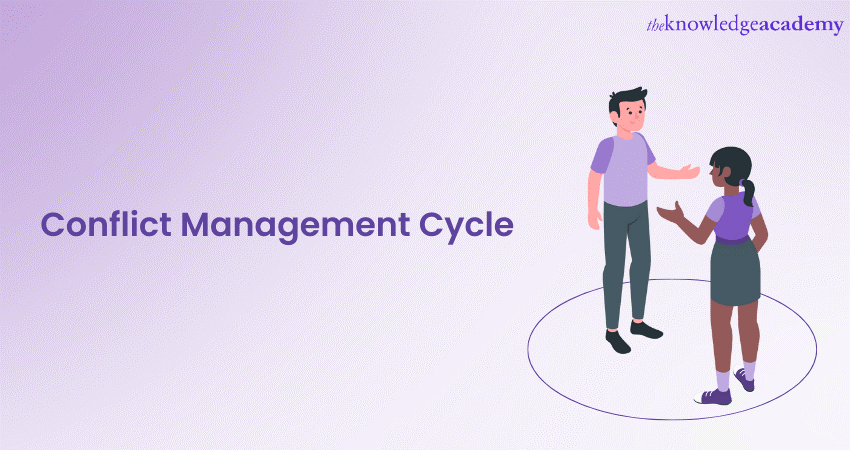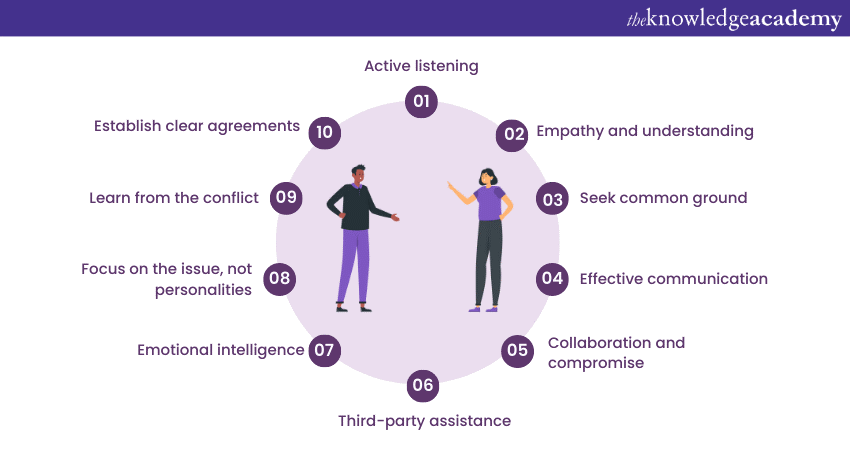We may not have the course you’re looking for. If you enquire or give us a call on +27 800 780004 and speak to our training experts, we may still be able to help with your training requirements.
Training Outcomes Within Your Budget!
We ensure quality, budget-alignment, and timely delivery by our expert instructors.

Conflicts are an inevitable part of human interactions, arising in various aspects of life, from personal relationships to professional settings. How people handle conflicts can significantly impact the outcomes and the quality of their relationships. Therefore, to navigate conflicts effectively, it is essential to understand the Conflict Management Cycle.
With the increased pace of life, conflicts arise more than ever today. According to the Myers Briggs research, out of the people surveyed, 36% reported that they have dealt with conflict often, very often, and even at the workplace. So, it’s time to address the issue to drive your business towards success.
But how to eliminate conflicts? What approach can organisations adopt? Read this blog to learn about Conflict Management Cycle. Also, explore various strategies to manage conflicts successfully.
Table of Contents
1) What is Conflict Management?
2) The Conflict Management Cycle explained
a) Stage 1: Proactive phase
b) Stage 2: Strategic phase
c) Stage 3: Reactive phase
d) Stage 4: Recovery phase
3) Key strategies for effective conflict resolution
4) Conclusion
What is Conflict Management?
Conflicts are natural occurrences that arise when there is a clash of interests, differing perspectives, or disagreement on certain issues. They can arise in various contexts, including personal relationships, professional environments, and even within our own minds. Conflict Management is crucial in maintaining healthy relationships, promoting effective communication, and fostering positive outcomes.
It refers to the process of handling and resolving conflicts constructively and productively. It involves a set of strategies, techniques, and skills aimed at understanding, addressing, and finding solutions to conflicts that arise between individuals and groups.
The goal of this method is not to eliminate conflicts entirely, as they are a natural part of human interactions. Instead, it focuses on managing conflicts to minimise negative consequences and maximise opportunities for growth, understanding, and collaboration.

The Conflict Management Cycle explained
Conflicts can be complex and dynamic, requiring a systematic approach to effectively address and resolve them. The Conflict Management Cycle provides a framework that guides us through the various stages of conflict resolution. Each stage plays a vital role in understanding, managing, and finding resolutions to conflicts. So, let’s explore the four key stages of this cycle:
Stage 1: Proactive phase
The proactive phase marks the initial stage of the Conflict Management Cycle. It involves taking preventive measures and creating an environment that minimises the likelihood of conflicts arising.
This stage primarily emphasises proactive communication, fostering positive relationships, and establishing clear expectations and guidelines. As a result, individuals and organisations can reduce the occurrence and severity of conflicts.
Stage 2: Strategic phase
The strategic phase in Conflict Management Cycle is where conflicts are identified, assessed, and analysed. This stage focuses on understanding the nature and causes of conflicts, gathering relevant information, and evaluating their potential impact.
Further, it involves conducting a thorough analysis of the underlying issues, interests, and needs of all parties involved. By employing active listening, effective communication, and problem-solving techniques, individuals can develop strategies for resolution and gain insights into the root causes of conflicts.
Ready to enhance your Conflict Management skills? Register for our Management Courses now.
Stage 3: Reactive phase
In the reactive phase, the focus shifts towards addressing conflicts immediately. This stage involves implementing the strategies and interventions developed during the previous phase. It requires effective communication, negotiation skills, and a willingness to find mutually beneficial solutions.
This phase aims to manage conflicts promptly and constructively, minimising further escalation and damage. By engaging in respectful dialogue, considering different perspectives, and exploring collaborative solutions, individuals can work towards resolving conflicts effectively.
Stage 4: Recovery phase
The recovery phase occurs after conflicts have been addressed and resolved. It involves reflecting on the conflict experience, learning from it, and implementing measures to prevent similar conflicts in the future.
This stage emphasises evaluating the outcomes, identifying lessons learned, and implementing changes to improve future Conflict Management. The recovery phase also focuses on rebuilding relationships, restoring trust, and fostering a positive environment.
Understanding the Conflict Management Cycle and its different stages empowers individuals and organisations to navigate conflicts more effectively. They can drive themselves towards opportunities for growth, understanding, and improved relationships.
Take the next step towards professional growth with our Problem Solving Training.
Key strategies for effective conflict resolution
Developing and honing Conflict Management Skills are crucial to effective resolution. By employing effective strategies, individuals can navigate conflicts and reach mutually beneficial resolutions. Here are key strategies to consider when aiming for effective conflict resolution:

a) Listen attentively to understand all perspectives without interruptions, fostering a deeper understanding of the conflict.
b) Cultivate empathy by considering others' emotions and needs, creating a more compassionate and constructive environment.
c) Focus on shared interests or goals to find collaborative solutions that benefit all parties involved.
d) Communicate clearly and respectfully using “I” statements to express feelings and encourage open dialogue.
e) Be open to alternative viewpoints and find win-win solutions through compromise.
f) Seek neutral third-party help when conflicts escalate or become complex, facilitating resolution.
g) Develop emotional intelligence to understand and manage emotions, promoting self-awareness and empathy.
h) Keep the focus on the conflict, separate individuals from the problem, and address it constructively.
i) Reflect on conflicts, identify lessons learned, and apply them to enhance future Conflict Management skills.
j) Define clear terms, responsibilities, and timelines to ensure understanding and commitment to the resolution.
Conclusion
The Conflict Management Cycle provides a comprehensive framework for effectively addressing and resolving conflicts. By embracing this cycle and employing the strategies, individuals can navigate conflicts with resilience and foster positive resolutions. They can also cultivate a more harmonious and productive environment in various aspects of life.
Gain an in-depth understanding of Conflict Management techniques with our Conflict Management Training.







 Top Rated Course
Top Rated Course



 If you wish to make any changes to your course, please
If you wish to make any changes to your course, please


